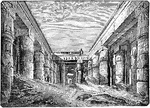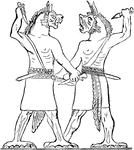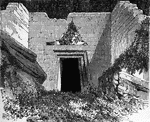
Tomb of Atreus
The Tomb of Atreus also known as the Treasury of Atreus is a tomb located in Mycenae, Greece built between…
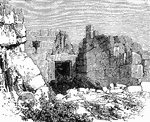
Gate of the Lions
The Gate of the Lions is located in Mycenae, Greece. It was the entrance to the city. On top of the…

Karnak
Karnak is a vast grouping of ruined temples, chapels, pylons and other buildings located mear Luxor,…

Assyrian Temple
This Assyrian Temple is located in present day Khorsabad, Northern Iraq. Khorsobad was the Assyrian…

Temples of Ellora
The temples of Ellora is an archeological site that was found in Aurangabad, India. It was built by…

The Parthenon
The Parthenon is a temple of the Greek Goddess Athena, who was considered as the protector of the city…

Temple of Neptune
The Temple of Neptune is located in the Graeco-Roman ancient city of Paestum, located in the Campania…

Roman Colosseum
This Roman Colosseum is located in Rome, Italy. It is the largest elliptical amphitheater that was built…

Ruins of the Baths of Caracalla
The ruins of the baths of Caracalla were roman public baths built in Rome, Italy between AD 212 and…

The Pantheon at Rome
The pantheon at Rome is a temple that was built to all the gods of Ancient Rome. It was built by Marcus…

Trajan's Column
The Trajan's column is a monument in honor of Emperor Trajan located in Rome, Italy. The column is a…
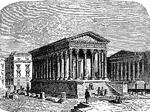
The Square House of Nîmes
The square house of Nîmes is also known as Maison Carree. It is an ancient Roman temple located in…
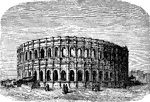
The Arena of Nîmes
The arena of Nîmes is a Roman amphitheater located in city of Nimes, France. The amphitheater was built…
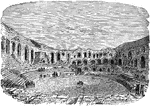
The Amphitheater of Arles
The amphitheater of Arles is a roman amphitheater in the southern French town of Arles. It is still…

Pont du Gard
The Pont du Gard is an aqueduct and bridge that was built over the Gard River by the Roman Empire. It…

Mosque of Cordoba
The Mosque of Cordoba was a former mosque and today is a Roman Catholic Cathedral located in the Andalusian…
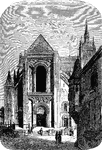
Cathedral of Mans
The Cathedral of Mans is a Roman Catholic Cathedral located in Le Mans, France. The Cathedral was built…

Cathedral of Chartres
The cathedral of Chartres is a roman catholic cathedral in Chartres, France. Built in a Gothic style,…

Cathedral of Rheims
The Cathedral of Rheims is also known as Notre-Dame de Rheims in French. It is a Roman Catholic Cathedral,…

Cathedral of Strasbourg
The cathedral of Strasbourg is a Roman Catholic cathedral located in Strasbourg, France. The church…

Metz Cathedral
The Metz Cathedral is also known as the St. Etienne de Metz in French. It is a Roman Catholic church…

Cathedral of Sienna
The Cathedral of Siena is a Roman Catholic Marian church located in Siena, central Italy. A medieval…

Theater of Vitruvius
The Theater of Vitruvius was a Roman Theater, named after Roman writer, architect and engineer Vitruvius…

Black-throated Murrelet
"Synthliborhamphus antiquus. Nipper-nosed Murrelet. Bill somewhat as in Brachyrhamphus, but stouter…

Glyptothek at Munich
"In contrast to the Berlin school is that of Munich, which was founded by Gärtner. Its influence, which…

Lazarist Church at Vienna
"In this city many individual tendencies are perceptible, but the predominant inclination is toward…

Explicit Monument
A monument is a type of structure either explicitly created to commemorate a person or important event…
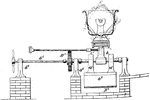
Reversible Enameling Cradle
Enameling is an old and widely adopted technology. The ancient Egyptians applied enamels to pottery…
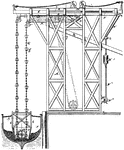
Elevating Apparatus
The first reference to an elevator is in the works of the Roman architect Vitruvius, who reported that…

DrogueParachute
The word "parachute" comes from "para", meaning "against" or "counter" in Ancient Greek, and "chute",…
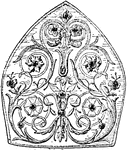
Mitre of Roman Catholic ArchBishop of Westminster Cardinal Vaughan
A mitre of Cardinal Vaughahan from the Roman Catholic Archbishop of Westminster. The hat was worn by…
Decorative Letter M
An illustration of a decorative letter M with a man who looks like a roman soldier inside.

Notre Dame Cathedral
An illustration of Notre Dame Cathedral in Paris, France. This building is also known as Notre Dame…
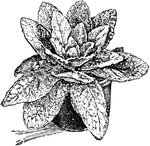
Verbascum Thapsus
Bears yellow toned flowers, used as funeral torches in early Greek and Roman society.
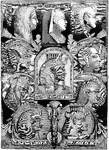
Celebrities of Ancient Egypt
Ten notable ancient Egyptian rulers, including Ramses III, Seti I, Gemahlin Amenophis III, Ptolemaeus…
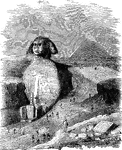
The Great Sphinx at Giza
A statue built on the Giza Plateau in Giza, Egypt, consisting of a lion with a human head. The Sphinx…

Obelisk of Heliopolis
A 68-foot stone pillar located at Al-Matariyyah part of Heliopolis. It is considered to be the earlier…
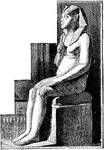
Statue of Amenophis IV
Also known as Akhenaten. Ruled as pharaoh of the Eighteenth Egyptian dynasty for 17 years.
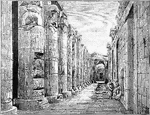
The Temple of Abydos
Built by Seti I and completed by his son Ramses II. The pillars in this temple contain carvings of very…
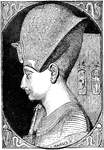
Ramses the Great
Also known as Ramses II. A profile portrait of Ramses the Great with carvings behind his head. He is…

Ruins of Thebes
The city of Thebes was a major city during the 18th Dynasty of Egypt. Portrays the wreckage of the city,…
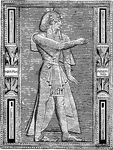
Menepta
Also known as Merneptah. He ruled Egypt as pharaoh for ten years, and was the thirteenth son of Ramessess…

Exodus of Israel
Put into effect by Menepta, he collected all of the leprous, unclean, and diseased people of Israel…
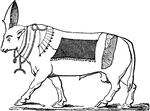
The Bull Apis
Also known as Hapis. In mythology, Apis was a commonly worshipped bull-deity in the Memphis region.
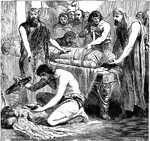
Process of Embalming
"When an Egyptian died the friends of the deceased went at once to the embalmer, By him they were shown…

Glazed Coffins, from Warka
"Another kind of coffins employed by the Chaldeans consisted of two large earthenware vessels, shaped…

Assyrian Mule
The animal life of Assyria was extremely varied. This image depicts a mule from this area.
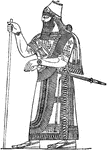
Assyrian King
"The Assyrian physiognomy, as determined by the sculptures exhumed from the ruins of Nimrud and Khorsabad,…

Assyrian War Chariot
"The stalwart character and aggressive bearing of the Assyrians were particularly shown in war. The…

Assyrian Princess in Full Dress
In ancient Assyria, princes, princesses, and priests vied with each other in luxury.

Assyrian Soldiers Fighting
A depiction of two soldiers fighting for Assyria, using bow and arrows against their enemies.
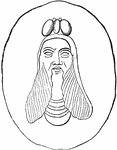
Image of Beelzebub, the Fly God
Literally means 'Lord of the Flies.' In Christian and Biblical texts, he is associated with a demon.



